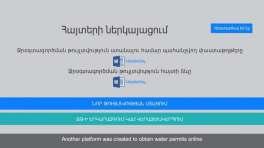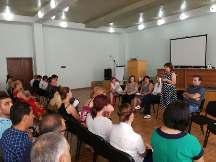
4 minute read
I. EXECUTIVE SUMMARY
The Ararat Valley is the largest depository of high-quality natural groundwater which is vital not only for Armenia but also for the region. All stakeholders, including the government and civil society organizations (CSOs), recognize the dreadful situation of water resource management in the Ararat Valley. Due to poor management, a lot of Ararat Valley, Armenia communities in the Ararat valley have extremely limited access to drinking and irrigation water. Demand to irrigation water increases due to the climate change and overissuance of water user permits leading to sharp depletion of groundwater resources. There is poor public participation and awareness in the water resource management process while involving residents of the Ararat Valley in the decision-making process will lead to quality and informed decisions thus ensuring public acceptance of adopted decisions.
The goal of the project is to contribute to the increase of water productivity, efficiency, and quality, as well as foster behavioral change to reduce the rate of groundwater extraction in the Ararat Valley.
Advertisement
Result Area (RA) 1: Policy and Regulatory Improvements to Foster Citizen Participation Identify gaps in the policy-regulatory environment in the water sector, impeding citizen participation in Ararat Valley, develop a Strategy for Improved Legislation on Participatory, Transparent and Accountable Water Resources
Management (Strategy), and a Road Map for improvements agreed upon amongst stakeholders. Improve the capacity of citizen groups and water users‟ associations to effectively advocate for transparent decision making in water management with constructive input of CSOs. Introduce public consultation mechanisms in support to Basin Management Organizations (BMOs) of the Ararat
Valley and for promoting participatory basin planning. RA 2: Participation in and oversight of water resources management Develop public oversight mechanisms: - Introduce consumer feedback tools using information communications technologies - Introduce community monitoring schemes for water quality and efficient use Build capacities of community stakeholders through targeted capacity-building activities in the use of public oversight mechanisms to monitor water resource management. Awarding community collaboration and watchdog small sub-grants for monitoring activities. Assist local governments in affected communities to ensure compliance of the local users with the regulatory framework, ensure public access to water-related information. RA 3: Public Awareness Education and Behavioral Change Undertake public awareness and education campaigns - Baseline and follow-up consumer and stakeholder surveys - Common messaging regarding water resource quality and use - Public awareness campaigns using a mix of integrated marketing communication tools Implement tailored stakeholder behavioral change interventions - Stakeholder mapping, assessment, and analysis for tailored outreach and strategic communication campaign RA 4: Small-Scale Water Infrastructure Pilots Projects Identify and develop pilot small-scale infrastructure projects designed and developed by capacitated communitybased organizations and residents leading to increased and sustained community water access.
Key Milestones Achieved
The Participatory Utilization and Resource Efficiency of Water (PURE Water) project reached the following milestones:
Milestones reached* Baseline Target Achieved
Notes People educated 0 700 2243/5.6% Schoolchildren, youth and community residents trained in water and (59%-women, 25%-youth) health, citizen participation, monitoring, advocacy, phone survey, journalism, integrated water management, participatory budgeting Residents participating in community 0 1,200 1,738/4.4% Public hearings, town halls, community meetings - strategy meetings (17%-women, 3.4%- youth) development, small infrastructure projects, water meters, social audit People voicing the necessity for water 0 3,000 8,304/20.7% Fish-farms, citizen scientists, citizen journalists through media articles, management improvements social audit, advocacy, awareness events, town-halls, study tours, changes in legislation People engaged in advocacy 0 - 2,114/5.3% Vedi, Pokr Vedi, Aygavan, Yeraskhahun (Lukashin, Armash, Aratashen) interventions at the local level Drinking water, irrigation water (supply, contracts People reached out by awareness 0 - 6260/15.6% Events and festivals; educational workshops; peer to peer exchange campaigns in the target community among communities; educational tours to fisheries, artesian wells Public information materials delivered 0 - 2000/5% Overview: Ararat Valley Water Resources; Questions and Answers (Q&A) drinking and irrigation water; Citizen participation; Water Users Rights and Responsibilities; Best practices of fish farms, desktop calendar, bookmarks for children Total people reached out in Ararat Valley 0 50,000 2,000,000 Yerkir Media, H1 TVs, Hetq, Websites, Facebook (FB) pages, Events and nationwide and festivals; educational workshops; peer to peer exchange among communities; educational tours to fisheries, artesian wells Legal support Week legislation 2 5 Assessment, Strategy, Road map, legal drafting to promote participation Infrastructure projects Deteriorated 5 5 Aratashen, Yeghegnut , Vedi, Pokr Vedi, and Khachpar infrastructure People benefited from infrastructure Interrupted or 24,000 24,000 Drinking water: 5,000 people(Aratashen and Yeghegnurt, Armavir projects scheduled water region), 24-hour water supply supply Irrigation water: 19,000 (Vedi, Pokr Vedi, and Khachpar, Ararat region) CSOs involved 30 27 The taskforce, Water Sector Public Advocacy Network (WPAN), small grants * Percentage for each figure under the column “Milestones reached” stands for a share of affected people in total population (40,000) of 12 communities






